
The Central Indo-Pacific is a biogeographic region of Earth's seas, comprising the tropical waters of the western Pacific Ocean, the eastern Indian Ocean, and the connecting seas.

Plectropomus laevis, known commonly as the black-saddled coral grouper, cluespotted coral trout, blacksaddled coral trout, blue-spot trout, Chinese footballer, footballer cod, footballer coral trout, oceanic coral trout or tiger trout, is a species of marine ray-finned fish, a grouper from the subfamily Epinephelinae which is part of the family Serranidae, which also includes the anthias and sea basses. It is found in the Indo-Pacific region.

The Solomon Islands archipelago is an archipelago in the western South Pacific Ocean, located northeast of Australia. The archipelago is in the Melanesia subregion and bioregion of Oceania. It forms the eastern boundary of the Solomon Sea. The archipelago forms much of the territory of Solomon Islands. The main islands are Choiseul, the Shortland Islands, the New Georgia Islands, Santa Isabel, the Russell Islands, the Florida Islands, Tulagi, Malaita, Maramasike, Ulawa, Owaraha, Makira, and Guadalcanal. The largest island, Bougainville Island, is geographically part of the Solomon Islands archipelago, while politically an autonomous region of Papua New Guinea. The nation state of Solomon Islands covers a subset of the Solomon Islands archipelago and includes isolated low-lying coral atolls and high islands including Sikaiana, Rennell Island, Bellona Island and the Santa Cruz Islands.
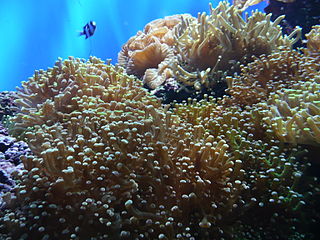
Euphyllia is a genus of large-polyped stony coral. Several species are commonly found in marine aquariums. The genus includes the following species:

Stylophora pistillata, commonly known as hood coral or smooth cauliflower coral, is a species of stony coral in the family Pocilloporidae. It is native to the Indo-Pacific region and is commonly used in scientific investigations.

Acropora grandis is a species of colonial stony coral. It is a large species with multiple branches forming a bush-like structure and is found on reefs and in lagoons. It is native to the tropical western Indo-Pacific and has a range extending from East Africa to the east coast of Australia.

Euphyllia ancora is a species of hard coral in the family Caryophylliidae. It is known by several common names, including anchor coral and hammer coral, or less frequently as sausage coral, ridge coral, or bubble honeycomb coral.

Euphyllia cristata is commonly called grape coral. E. cristata is a kind of stony or hard coral in the family Euphylliidae; it also belongs to the genus Euphyllia in the order of Scleractinia. E. cristata has a wide range of distribution throughout the tropical waters of the Indo-West Pacific area with a large presence in Indonesia. However, despite this large range of distribution, E. cristata has a slightly lower abundance compared to other species, making them a little more uncommon to find. They are typically found in shallow waters from 1–35 meters deep.

Acropora aculeus is a species of acroporid corals found throughout the Indian Ocean, the central Indo-Pacific, Australia, southeast Asia, Japan and the East China Sea. It is also present in the western Pacific Ocean. It is an uncommon species and is particularly prone to coral bleaching, disease, and crown-of-thorns starfish predation; it is also harvested for use in aquaria, and the International Union for Conservation of Nature has assessed it as being a "vulnerable species". Habitat loss is a big concern.

Pocillopora grandis, is a colonial species of stony coral in the family Pocilloporidae. It is known commonly as antler coral, and is found in the Indo-West Pacific to the Eastern Tropical Pacific.

Turbinaria reniformis, commonly known as yellow scroll coral, is a species of colonial stony coral in the family Dendrophylliidae. It is native to the Indo-Pacific region. The International Union for Conservation of Nature has rated its conservation status as being "vulnerable".

Herpolitha is a monotypic genus of mushroom corals in the family Fungiidae. The only member of the genus is Herpolitha limax, commonly known as the tongue, slipper, mole or striate boomerang coral. It is a free-living species and is native to reefs and lagoons in the Indo-Pacific region. The International Union for Conservation of Nature has assessed this coral as being of "least concern".

Blastomussa merleti, commonly known as pineapple coral, is a species of large polyp stony coral. It is unclear in which family the genus Blastomussa belongs. This coral is native to the west and central Indo-Pacific region and is sometimes used in reef aquaria.
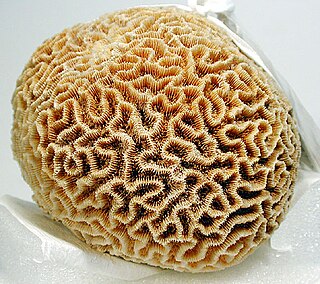
Goniastrea favulus, also known as the lesser star coral, is a species of stony coral in the family Merulinidae. It occurs in shallow water in the Indo-Pacific region. This is an uncommon species of coral and the International Union for Conservation of Nature has rated its conservation status as being "near threatened".

Euphyllia paradivisa, or branching frogspawn coral, is a species of large-polyped stony coral belonging to the Euphylliidae family. It shares the common name of "frogspawn coral" with Euphyllia divisa, but is differentiated as the "branching" frogspawn whereas Euphyllia divisa has a "wall" structure. It is a commonly kept species in the marine aquarium hobby.
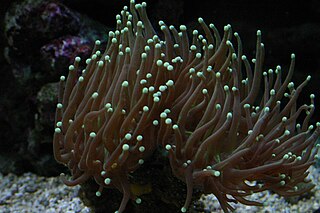
Euphyllia glabrescens is a species of large-polyped stony coral belonging to the family Caryophylliidae. Its common name is the torch coral due to its long sweeper tentacles tipped with potent cnidocytes. It is a commonly kept species in the marine aquarium hobby, particularly specimens from Indonesia and Fiji, who fulfilled annual export quotas of 28,000 and 6,000 pieces, respectively, in 2005.
Euphyllia baliensis, commonly known as bubble coral, is a species of large-polyped stony coral belonging to the family Euphylliidae.

Oxypora glabra is a species of large polyp stony coral in the family Lobophylliidae. It is a colonial coral with thin encrusting laminae. It is native to the central Indo-Pacific.
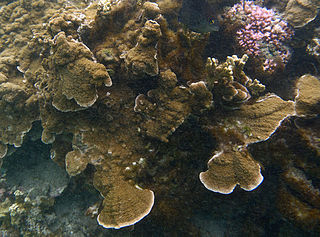
Echinophyllia aspera, commonly known as the chalice coral, is a species of large polyp stony corals in the family Lobophylliidae. It is a colonial coral which is partly encrusting and partly forms laminate plates or tiers. It is native to the western and central Indo-Pacific.
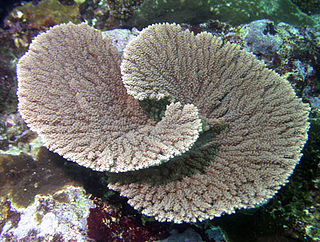
Acropora clathrata, commonly known as lattice table coral is a species of stony corals belonging to the family Acroporidae. They are a zooxanthellate coral, which are generally found in fringing reefs, sheltered reefs and back reef habitats, between the depths of 5–40 m (16–131 ft).





















